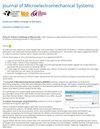60克FSR, 6 μg稳定性调频时间开关加速度计通过梳状手指
IF 3.1
3区 工程技术
Q2 ENGINEERING, ELECTRICAL & ELECTRONIC
引用次数: 0
摘要
本文提出了一种新的调频平面内加速度计的设计,其频率调谐机制是通过梳状指电极来实现的。这种方法解除了对证明质量反相模式行程范围的限制,从而增加了共振电流,进而改善了相位噪声。通过静电有限元模型对基本调谐指胞进行优化,并将其纳入主传感器设计中。实验数据证实了设计的有效性,在噪声方面实现了几乎一个数量级的改进:在保持$\mathbf {\pm 60\, \text {g}}$满量程的情况下,实现了$\mathbf {45\, \mu \text {g}/\sqrt {\text {Hz}}}$速度随机游走和$\mathbf {6\, \mu \text {g}}$ 1000 s时的偏置稳定性,从而在25 hz带宽上实现了120 dB的动态范围。尺度因子的可重复性、温度偏移和振动抑制也得到了关注、测量和讨论。[2025-0037]本文章由计算机程序翻译,如有差异,请以英文原文为准。
60-g FSR, 6-μg Stability FM Time-Switched Accelerometers Through Shaped Comb Fingers
The work presents a new design of a frequency-modulated (FM) in-plane accelerometer in which the frequency-tuning mechanism is implemented through shaped comb finger (SCF) electrodes. This approach releases the constraints on the travel range of the proof-mass antiphase mode, thus increasing the resonance current and, in turn, improving phase noise. The elementary tuning finger cell is optimized via electrostatic finite element models and is then incorporated into the main sensor design. Experimental data confirm the design validity, achieving almost an order of magnitude improvement in terms of noise: $\mathbf {45\, \mu \text {g}/\sqrt {\text {Hz}}}$ velocity random walk and $\mathbf {6\, \mu \text {g}}$ bias stability at 1000 s are achieved, while holding $\mathbf {\pm 60\, \text {g}}$ full-scale range, thus leading to 120 dB dynamic range on a 25-Hz bandwidth. Scale factor repeatability, offset drift in temperature and rejection of vibrations are also given attention, measured and discussed. [2025-0037]
求助全文
通过发布文献求助,成功后即可免费获取论文全文。
去求助
来源期刊

Journal of Microelectromechanical Systems
工程技术-工程:电子与电气
CiteScore
6.20
自引率
7.40%
发文量
115
审稿时长
7.5 months
期刊介绍:
The topics of interest include, but are not limited to: devices ranging in size from microns to millimeters, IC-compatible fabrication techniques, other fabrication techniques, measurement of micro phenomena, theoretical results, new materials and designs, micro actuators, micro robots, micro batteries, bearings, wear, reliability, electrical interconnections, micro telemanipulation, and standards appropriate to MEMS. Application examples and application oriented devices in fluidics, optics, bio-medical engineering, etc., are also of central interest.
 求助内容:
求助内容: 应助结果提醒方式:
应助结果提醒方式:


